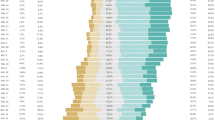Abstract
Purpose
We investigated alternative ways of understanding the relationships among co-occurring symptoms in individuals with advanced cancer. While factor analysis has been increasingly used to identify symptom clusters, we argue that structural equation modeling is more appropriate because it permits investigating and testing of a greater variety of potential causal interconnections among symptoms.
Methods
The sample included 82 palliative patients whose symptom scores were obtained from a database of the Capital Health Regional Palliative Care Program in Alberta, Canada, from 1995 to 2000. Data were analyzed using exploratory factor analysis (SPSS PASW 18.0.0, 2009) and compared to previous results obtained using structural equation modeling (LISREL 8.8, 2009).
Results
Factor models failed to fit the covariance data, even though a single factor “explained” nearly half the variance. Structural equation models fit the data and explained an average of 66 % of the variance in the dependent latent variables. The factor analytic estimates were not clinically useful because they failed to correspond to the reasonable underlying common causes of the symptoms. Structural equation models, on the other hand, incorporated and tested specific clinically anticipated causal relationships among the symptoms and changes in those symptoms over time.
Conclusion
We used factor analysis to reanalyze data previously investigated with structural equation modeling and found that the structural equation models fit the data better and were more interpretable from a clinical perspective. We caution that factor models should be tested for consistency with the data and critically examined for inconsistencies with clinical understandings of the causal foundations of coordinated symptoms.

Similar content being viewed by others
References
Skillen D, Anderson M, Da R, Stephen T (2010) Health assessment and physical examination. In: Ross-Kerr J, Wood M (eds) Canadian Fundamentals of Nursing, Revised, 4th edn. Mosby, Toronto, ON, pp 540–634
Dodd MJ, Miaskowski C, Paul SM (2001) Symptom clusters and their effect on the functional status of patients with cancer. Oncol Nurs Forum 28:465–470
Dodd MJ, Janson S, Facione N, Faucett J, Froelicher E, Humphreys J, Lee K, Miaskowski C, Puntillo D, Rankin S, Taylor D (2001) Advancing the science of symptom management. J Adv Nurs 33(5):668–676
Steele L, Steele J (2009) Symptom management. In: Larsen P, Lubkin I (eds) Chronic Illness: Impact and Intervention, 7th edn. Jones and Bartlett, Boston, MA, pp 389–432
Mulaik SA (2010) Foundations of Factor Analysis, 2nd edn. Chapman and Hall/CRC, London
Atkas A, Wals D, Rybicki L (2010) Symptom clusters: myth or reality? Palliat Med 24(4):373–385
Olson K, Hayduk L, Cree M, Cui Y, Quan H, Hanson J, Lawlor P, Strasser F (2008) The changing causal foundations of cancer-related symptom clustering during the final month of palliative care: a longitudinal study. BMC Med Res Methodol 8:36
Hayduk L, Olson K, Quan H, Cree M, Cui Y (2010) Temporal changes in the foundations of palliative care symptoms. Qual Life Res 19:299–306
Bruera E, Kuehn N, Miller MJ, Selmser P, Macmillan K (1991) The Edmonton Symptom Assessment System (ESAS): a simple method for the assessment of palliative care patients. J Palliat Care 7(2):6–9
Kaiser HF (1958) The varimax criterion for analytic rotation in factor analysis. Psychometrika 23:176–200
Kaiser HF (1961) A note on Guttman's lower bound for the number of common factors. Br J Stat Psychol 14(1):1
Cattell RB (1966) The Scree Test for the number of factors. Multivar Behav Res 1:245–276
Kaiser HF (1963) Image analysis. In: Harris CW (ed) Problems in measuring change. University of Wisconsin Press, Madison WI, pp 156–166
Hayduk L, Cummings G, Boadu K, Pazderka-Robinson H, Boulianne S (2007) Testing! Testing! One two three—testing the theory in structural equation models. Personal Individ Differ 42(5):841–850
Barrett P (2007) Structural equation modeling: adjudging model fit. Personal Individ Differ 42(5):815–824
Hayduk L, Littvay L (2012) Should researchers use single indicators, best indicators, or multiple indicators in structural equation models? BMC Med Res Methodol 12:159
Hayduk LA, Glaser DN (2000) Jiving the four-step, waltzing around factor analysis, and other serious fun. Struct Equ Model 7(1):1–35
Hayduk LA, Glaser DN (2000) Doing the four-step, right-2-3, wrong-2-3: A brief reply to Mulaik and Millsap; Bollen; Bentler; and Herting and Costner. Struct Equ Model 7(1):111–123
Hayduk L, Pazderka-Robinson H (2007) Fighting to understand the world causally: three battles connected to the causal implications of structural equation models. In: Outhwaite W, Turner S (eds) Sage Handbook of Social Science Methodology. Sage Publications, London, pp 147–171
Hayduk LA (1996) LISREL issues debates and strategies. Johns Hopkins University Press, Baltimore
Lederman W (1937) On the rank of the reduced correlation matrix in multiple-factor analysis. Psychometrika 2:85–93
Pearl J (2000) Causality: models, reasoning, and inference. Cambridge University Press, Cambridge UK
Acknowledgments
The authors acknowledge the financial support of the Killam Cornerstone Fund at the University of Alberta and the analytic assistance provided by Dr. Y. Cui in the Department of Educational Psychology at the University of Alberta. The authors also acknowledge Mr. Hue Quan, currently the data manager for the Edmonton Zone Palliative Care Program, who provided the original data set.
Conflict of interest
The University of Alberta provided 4 months of graduate student support for Ms. Thomas and employs both Drs. Olson and Hayduk, but had no control over the data or analysis. The authors agree to allow the journal to review their data if requested.
Author information
Authors and Affiliations
Corresponding author
Rights and permissions
About this article
Cite this article
Olson, K., Hayduk, L. & Thomas, J. Comparing two approaches for studying symptom clusters: factor analysis and structural equation modeling. Support Care Cancer 22, 153–161 (2014). https://doi.org/10.1007/s00520-013-1965-6
Received:
Accepted:
Published:
Issue Date:
DOI: https://doi.org/10.1007/s00520-013-1965-6




